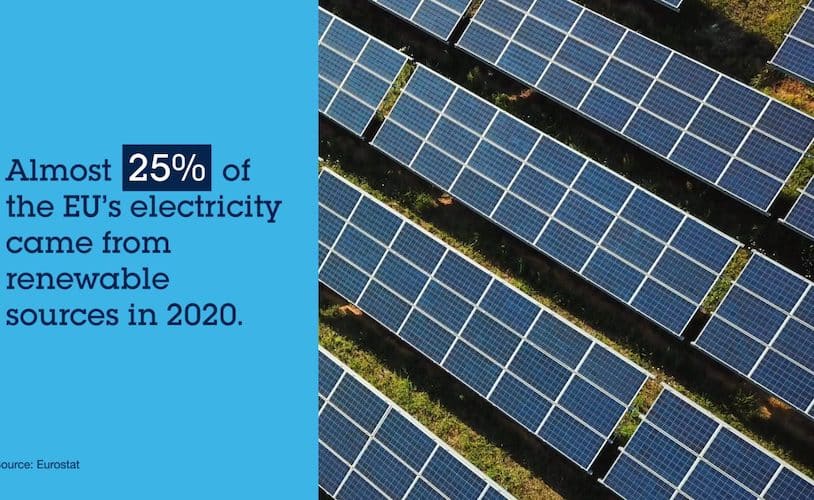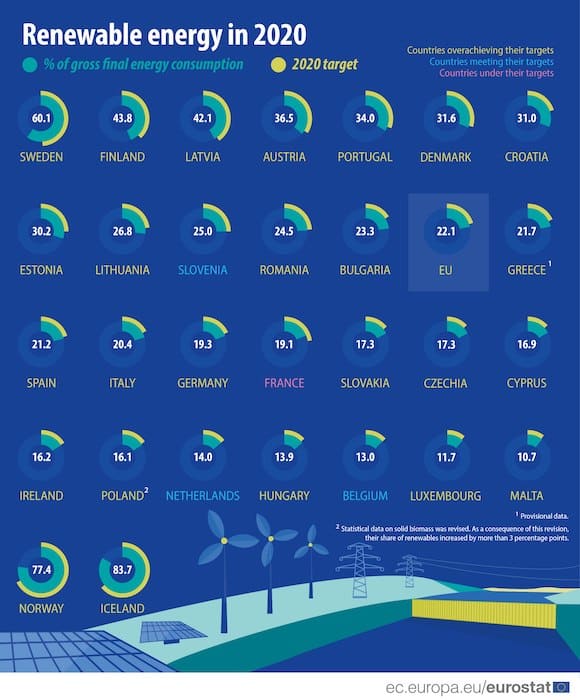With the current state of the world, it is clear the global energy sector must accelerate the shift from fossil-based systems of energy production to renewable energy sources. Power semiconductors are a key part of this transition. They play an important role in energy conversion, transfer, storage, and increasingly, ensuring that the electricity grid is responsive and efficient.

In Europe, almost a quarter of the EU’s electricity came from renewable sources in 2020. Spain and Greece are among the leading European countries in embracing solar power while the UK and Denmark have constructed large offshore generation plants for wind power. In hydropower production, Norway and France are the leaders.
Factors impeding further renewable adoption
While renewable electricity growth is increasing, there are still significant barriers to overcome. Renewable energy does not work in the same way as coal-fired power plants. There are fluctuations in output, due to the intermittent nature of some renewable energy sources. The excess electricity generated must therefore be stored, so it is available for use later. The problem is exacerbated in the case of solar power because input only comes during the day. But electric usage peaks in the evening when people are at home. More sophistication is therefore required to ensure that stable, reliable power is delivered on demand.

Boosting efficiency using the latest power semiconductors
Power semiconductors are fundamental components to control the power generation and connection of the network from renewable energy sources. They play a vital part in converting power generated from renewables and transmitting it to the grid. For solar panels, the transfer of power is executed through an array of supporting semiconductor devices. These are responsible for adapting the electricity generated by the panels, which is initially in a DC form, into the AC form required for power grid distribution. The efficiency of this conversion is critical to power output and systems costs.
STMicroelectronics is a leader in this arena. ST’s portfolio offers a wide range of products including high-performance silicon devices and the latest generation of wide bandgap technology to satisfy the high efficiency required by renewable energies. The core of this offer is based on the advanced and innovative properties of new wide bandgap semiconductors, using silicon carbide instead of silicon. These semiconductor devices can achieve efficiencies that were previously unobtainable. ST has been at the forefront of the development of SiC technology for over 25 years. Compared to what was previously possible with silicon-based technology, ST’s wide bandgap devices can minimize energy wastage by cutting the switching losses by half.
They do so while decreasing the size and weight leading to around 50% reduction in installation costs.
Thanks to their ability to turn on and off far faster, these groundbreaking semiconductors can attain greater conversion efficiencies and handle far greater currents and voltages than previous devices could. This means, for example in the case of solar panels, that each one can support a greater number of solar cells and power, ensuring further cost advantages. In addition, control electronics that were previously separate from the rest of the solar panel, can now be packaged in with it. This brings benefits in relation to heightened reliability and efficiency, as well as reducing the price.
Renewables are changing the power landscape
Advanced semiconductor technologies are also helping transform the power network. The classical power grid operates using what can be thought of as a ‘top-down’ arrangement. The power plants burn fossil fuels generating electricity, and this is then transported via power lines to homes, offices, and factories. A grid based on renewables, however, is structured very differently. It compromises a multitude of distributed power generation sites, rather than just a few large ones. This means that the grid has more places to draw electricity from and may be connected to numerous storage sites used to supplement the electricity generated with additional amounts when required for peaks in demand. Vehicle-to-grid (V2G) technology is also taking off. This means that a battery of an EV can be used to store renewable energy and feed it back to the grid when needed.
Grids, therefore, will increasingly need to be flexible and more adaptable than they have been in the past by leveraging sophisticated processing technology. They will have the intelligence needed to respond to constantly changing situations – sometimes delivering electricity to certain locations, and at other times drawing electricity from them. As a result, there will be an ‘Internet of Energy.’ And, this continuous two-way interaction, between generation and consumption, must be managed.
Microgrids
This more distributed electrical generation strategy relies on the implementation of microgrids. Here small communities, such as hospitals, university campuses, industrial facilities, or office complexes can make themselves more energy-autonomous through local renewable resources (such as a wind turbine, a water wheel, or a bank of solar panels) to generate electricity. If there is a shortfall, additional electricity can be drawn from the main grid. Or they can contribute to the main grid when the energy sourced exceeds local needs. To efficiently manage a complex electric energy distribution network, utilities must have an instantaneous view of energy input and consumption. Encouraging the right consumer behavior helps to flatten out peaks in demand. Semiconductors are the key enabling technologies for this so-called smart grid concept. ST has a comprehensive offer of power line communications and smart metering solutions that provide the underlying technology.
Decarbonization efforts will increase the demand for renewable energy and its supporting infrastructure. In this ongoing transition, semiconductors are demonstrating their importance to a new emerging clean energy economy and helping to unleash innovations for secure, scalable, and reliable energy solutions.





